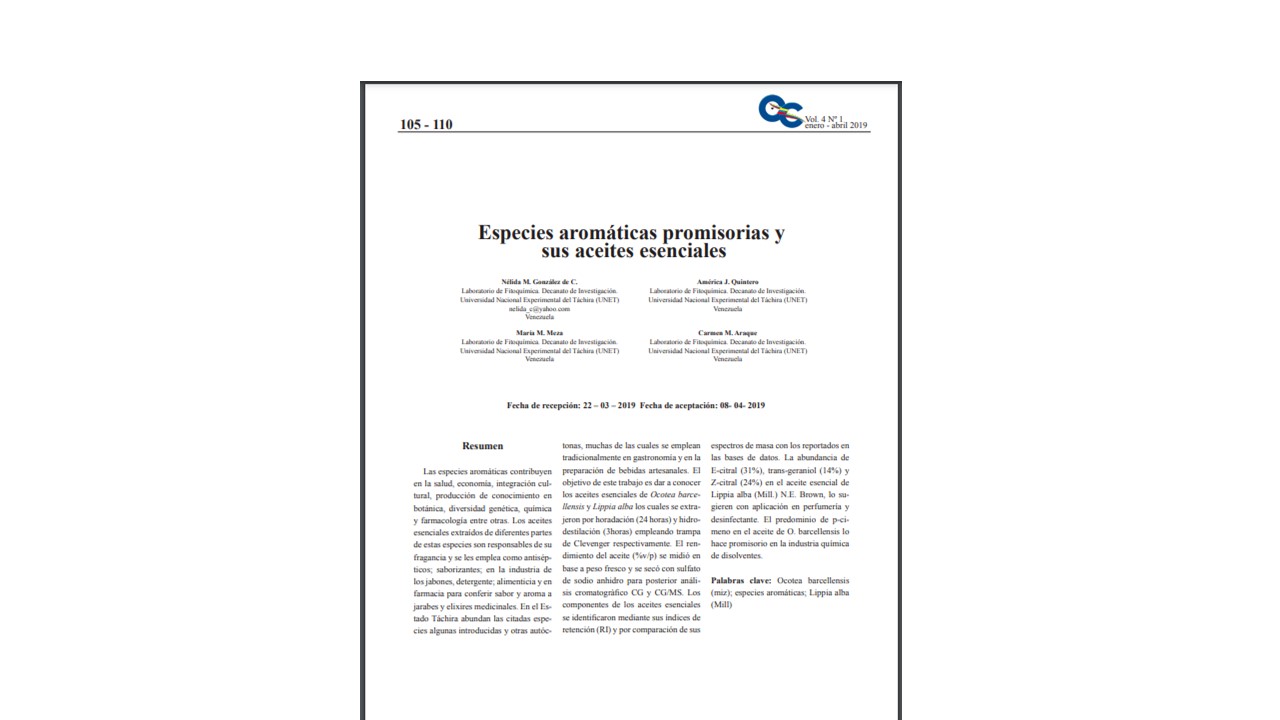Promising aromatic species and their essential oils
Keywords:
Ocotea barcellensis (miz), aromatic species, Lippia alba (Mill)Abstract
The aromatic species contribute to health, economy, cultural integration, production of knowledge in botany, genetic diversity, chemistry and pharmacology among others. The essential oils extracted from different parts of these species are responsible for their fragrance and are used as antiseptics; flavors; in the soap industry, detergent; food and pharmacy to confer flavor and aroma to medicinal syrups and elixirs. In the State Táchira abound the mentioned species some introduced and other autochthonous, many of which are used traditionally in gastronomy and in the preparation of artisanal drinks. The objective of this work is to make known the essential oils of Ocotea barcellensis and Lippia alba which were extracted by horadación (24 hours) and hidrodestilación (3 hours) using Trap Clevenger respectively. The yield of the oil (% v / p) was measured based on fresh weight and dried with anhydrous sodium sulfate for subsequent chromatographic analysis CG and CG / MS.The components of the essential oils were identified by their retention indexes (RI) and by comparison of their mass spectra with those reported in the databases. The abundance of E-citral (31%), trans-geraniol (14%) and Z-citral (24%) in the essential oil of Lippia alba (Mill.) N.E. Brown, they suggest it with application in perfumery and disinfectant. The predominance of p-cymene in O. barcellensis oil makes it promising in the chemical solvent industry.
Downloads
References
Adams, R. (1995). Identification of Essential Oil Components by Gas Chromatography quadropolke Mass Spectroscopy. Allured Publishing Corporation,Carol Strem, Illinois.
Davies, N. (1990). Gas chromatographic retention index of monoterpenes and sesquiterpenes on methyl silicone and carbowax 20M phases. J. Chromatogr. A,503 :1-24.
Moriarity D., Bansal A., Coleb R., Takaku S., Haber W and Setzer W. (2007) .Selective Cytotoxic Activities of Leaf Essential Oils from Monteverde, Costa Rica. Natural Product Communications. 2,(12): 1263-1268
Setzer W., Stokes S., Penton A., Takaku S., Haber W., Hansell E., Caffrey C and McKerrow J. (2007). Cruzain Inhibitory Activity of Leaf Essential Oils of Neotropical Lauraceae and Essential Oil Components. Natural Product Communications. 2,(12): 1203-1210.
Mesa A,. Montiel J., Betancur G., Bueno J., Baena A., Duran J., Martinez J and Stashenko E.(2010). Antifungal Activity and Chemical Composition of the Essential Oils of Lippia alba (Miller) N.E Brown Grown in Different Regions of Colombia. The Journal of Essential OilResearch. 22, (6): 568-574.
Durán D., Monsalve L., Martínez J y Stashenko E. (2007). Estudio comparativo de la composición química de aceites esenciales de Lippia alba provenientes de diferentes regiones de Colombia, y efecto del tiempo de destilación sobre la composición del aceite Scientia et Technica año xiii, 33: 435-438

Downloads
Published
How to Cite
Issue
Section
License

This work is licensed under a Creative Commons Attribution-NoDerivatives 4.0 International License.







